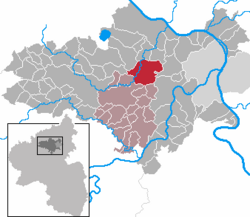Ochtendung
Municipality in Rhineland-Palatinate, Germany From Wikipedia, the free encyclopedia
Ochtendung is a municipality in the district of Mayen-Koblenz in Rhineland-Palatinate, western Germany.
Ochtendung | |
|---|---|
| Coordinates: 50°20′53″N 7°23′23″E | |
| Country | Germany |
| State | Rhineland-Palatinate |
| District | Mayen-Koblenz |
| Municipal assoc. | Maifeld |
| Government | |
| • Mayor (2019–24) | Lothar Kalter[1] (SPD) |
| Area | |
• Total | 24.08 km2 (9.30 sq mi) |
| Elevation | 200 m (700 ft) |
| Population (2022-12-31)[2] | |
• Total | 5,595 |
| • Density | 230/km2 (600/sq mi) |
| Time zone | UTC+01:00 (CET) |
| • Summer (DST) | UTC+02:00 (CEST) |
| Postal codes | 56299 |
| Dialling codes | 02625 |
| Vehicle registration | MYK |
| Website | www.ochtendung.de |

Geography
Ochtendung lies between the A 48 and A 61 motorways and has designated junctions from both. The village lies on the Nette and is neighboured by the municipalities of Lonnig, Bassenheim, Plaidt, Kruft and Saffig. Up until a few years ago, the B 258 road started in Koblenz before running through Ochtendung and Mayen towards Belgium, passing the Nürburgring. The stretch between Koblenz and Mayen was regraded due to the proximity to the A 48 and has since been the L 98.
Municipal Division
The districts Alsingerhof, Emmingerhof, Fressenhöfe Waldorferhof and Sackenheimerhöfe (previously a Bassenheim district) make up the municipality of Ochtendung.
Etymology
The name of the village is derived from the word Thing or Ding (Ochtendung). A 'Thing' was a governing assembly in Germanic societies.
Politics
This section needs to be updated. (August 2021) |
The Gemeinderat (comparable to the town council in English) of Ochtendung consists of 22 council members, voted in after the local elections of 7 July 2009 and headed by the Ortsbürgermeister in a voluntary position, as per the custom in the state of Rhineland Palatinate for village municipalities. This position is similar to the position of a town mayor.
The allocation of seats after the election is as follows:
SPD 11 seats
CDU 7 seats
FWG1 2 seats
WG Ich tu's (I do it) 2 seats
Sights and Tourism
- Wernerseck Castle
- Karmelenberg, a volcanic cinder cone
- Kulturhalle Ochtendung, used for holding special events
- Remains of the town wall
- Cycle and Sculpture Trail between Ochtendung and Polch
Famous residents
Jakob Vogt (1902–1985) Weightlifter
Jürgen Weigt (born 1957) Brigadier in the German Army
Peter Peters (born 1962) Journalist and football Functionary
Kristin Silbereisen (born 1985) Table Tennis Player
Sources
Human Evolution, 19,1 S. 1 - 8 (2004)
Terra Nostra, Schriften der GeoUnion Alfred-Wegener-Stiftung, 2006/2 (Kongresszeitschrift)
Dr. Axel von Berg's discovery (German Only)
Local Election Results 2009 (German Only)
References
Wikiwand - on
Seamless Wikipedia browsing. On steroids.




